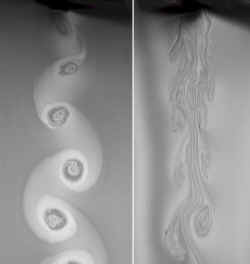Polymers Improve the Flow

Add a pinch of the right chemical to the water, and a fire hose will squirt it twice as far. This puzzling effect of polymers on liquid flow has also been used for decades to reduce friction in all sorts of fluid-carrying pipes, but the physical explanation remains mysterious. The 27 December PRL presents a new look at the problem by a European duo who found the same easing of friction between two layers of liquid. The smooth interface between liquids, compared with the rough surface of a solid, may provide an improved arena for studying the effect.
A very small concentration of polymers dissolved in a liquid can reduce friction with the pipe walls by more than 50%, but it only works in turbulent flows, where high speed and friction cause some disorganized motion of the fluid at the edges. “This has been known for decades, [but] we still can’t seem to sort out what’s going on,” says Walter Goldburg of the University of Pittsburgh. “There are models,” adds Daniel Bonn of the Ecole Normale Supérieure in Paris, “and the models have all been proven wrong.”
Researchers often study the so-called turbulent drag reduction effect by looking at the friction of fluids flowing through pipes, but Bonn and Osanne Paireau, now of the Southampton Oceanography Centre in the UK, wanted to observe one liquid rubbing against another because it would be simpler: The system is essentially two-dimensional, and the interface is smoother than a liquid-solid interface.
They loaded a cell with two different types of concentrated salt water that formed 3-mm-thick, nonmixing layers. Under the flat, rectangular cell was an array of magnets with alternating poles, and the magnetic field penetrated only 2 mm into the lower liquid layer. Running an electric current across the cell and through the salt water caused an array of turbulent eddies to form in the lower layer, which dragged the upper layer along, to some extent. Using a video camera, the team’s computers followed tracer particles in the upper layer and measured their velocities.
Paireau and Bonn found that adding just 50 parts per million by weight of the polymer PEO to either layer dramatically reduced the ability of the lower layer to drag the upper layer into turbulent motion. With the polymer added, the upper layer gained only half the kinetic energy it had gained without the polymer.
“It’s a very neat experiment,” says Goldburg, but “it sort of deepens the mystery of what these polymers are doing.” He explains that many researchers believe the friction reduction should occur only at levels of turbulence much higher than that created in Bonn and Paireau’s experiments. Goldburg believes the technique of looking at liquid-liquid friction may be very useful in future studies of drag reduction, and the work even gave him ideas for his own future experiments. “You can’t ask for much more of a Phys. Rev. Letter than that,” says Goldburg.


